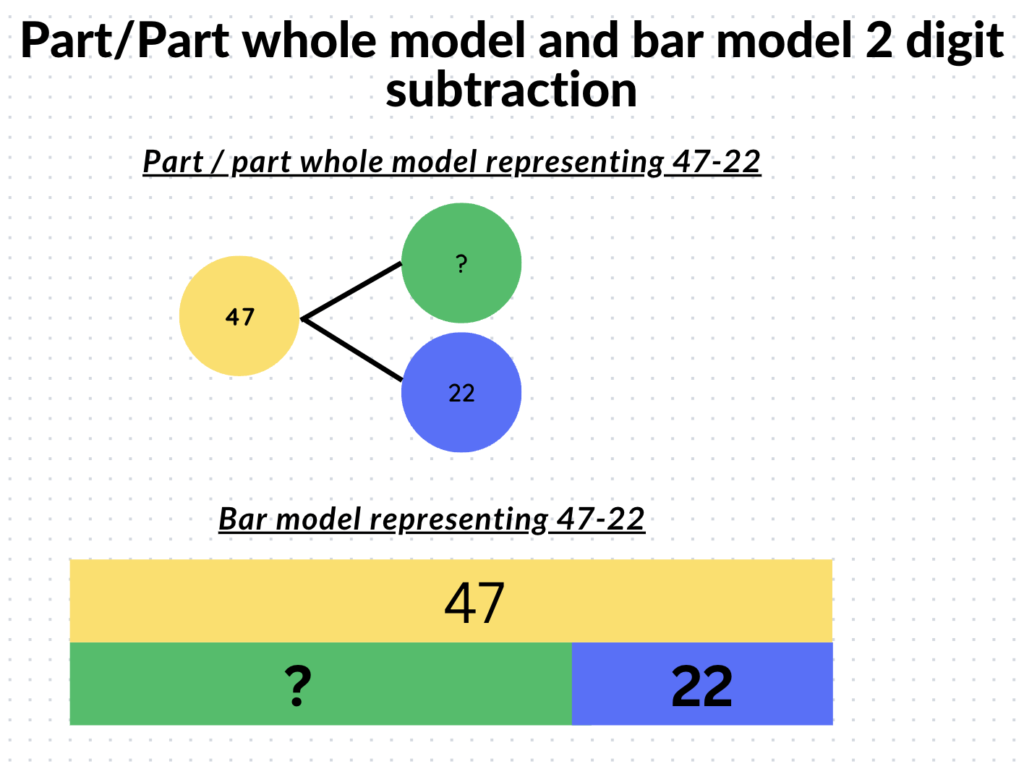One of the trickier concepts in early maths learning is that of subtraction. As children in Guernsey preschools and Reception begin learning to count in a linear way, starting from zero and counting up, the model of numbers getting bigger is better embedded in children’s understanding than that of counting backwards. Although teachers and maths tutors in Guernsey dedicate plenty of learning and teaching time to this, it is still a concept that many children find challenging. Therefore, it is not surprising that many children need additional support around written methods which support early and primary school learning in subtraction.
As many parents will recognise, the methods taught in Guernsey primary schools are quite different from what they learned themselves in Key Stage 2. The methods used come from significant research by experts in mathematical understanding and development, and are now fairly standard across many countries. There may be small variations, even in Guernsey, between methods; your child’s teacher or maths tutor should be able to advise you as to which stage of calculation your child is currently using. You can also ask for a copy of your school’s calculations policy which will outline the progression of methods used.
Prior learning
In Reception and Key Stage One, children will have practiced lots of counting both forwards and backwards, been taught the basics of place value (at least to 2 digits) and will have used a range of maths equipment such as ten frames, numicon, counters, and Base 10 or Dienes equipment to support their calculations in subtraction.
Numberlines
Lots of the fundamentals of using a numberline for subtraction are similar to the addition method. The differences are the direction of travel along the line – left to right – and that the jumps are under the line, jumping backwards. Here are some progressive examples of this method in action.
It is important that your child has a firm understanding of place value before starting to use the following methods, as they rely on children being able to partition a two-digit number into tens and ones, as well as realise that a tens jump and a ones jump have different values.
Usually, children will be ready to move onto using a partitioning method for column subtraction once they have a good understanding of place value up to hundreds, tens and ones. However, many teachers and maths tutors in Guernsey like to continue to use a numberline method until this knowledge is fully embedded.
Partitioning method
Much like the addition partitioning method, the subtraction partitioning method relies on children’s understanding of place value, and being able to partition a two digit number into tens and ones. It is also key that although the children are performing a subtraction calculation, a partitioned number is still shown as e.g. 47 becomes 40+7 as shown below:
One of the hardest concepts in subtraction for children to grasp, and one which our maths tutors in Guernsey spend a lot of time working on with students, is that of ‘exchanging’ or ‘repartitioning’. This happens when using any variation of the column method when there are ‘not enough’ of a number to be able to subtract while staying in positive numbers. Here is how this would be taught in most Guernsey schools using two digit numbers. This is a method which many children need extra time and tutoring to master.
Once children can confidently ‘exchange’ or repartition to make subtraction possible, they can then move onto problems which require them to exchange hundreds, thousands or bigger numbers.
Once a child is fully confident with exchanging method in thousands, hundreds and tens, including situations where zero is used as a placeholder (e.g. 4209 – 1183), and where more than one exchange must be made, then they are ready to begin to use the standard written method for subtraction.
How else can subtraction be shown?
The Singapore Bar Model and Part/Part whole models are used in Guernsey schools to help children visualise what a particular problem is asking learners to do. As with the addition models, the models themselves do not solve the arithmetic, but they do give a visual representation of what is being asked.
What’s the take away?
Ultimately, the methods taught progressively to children before they attempt the formal written methods are designed to carefully develop a child’s understanding. Guernsey’s teachers and maths tutors are experienced in making sure that children have the necessary skills and confidence before moving on to the next stage. To support your child’s learning, alongside learning how these methods work, simple counting backwards in ones, tens and hundreds can really help children to embed understanding of subtraction. If you think this is an area of maths where your child needs more support, please get in touch to see how one of our Guernsey maths tutors can help your child.













